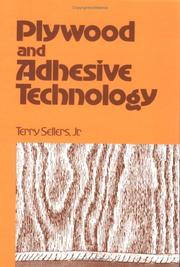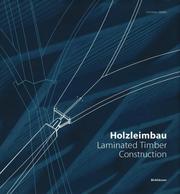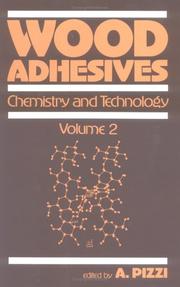| Listing 1 - 8 of 8 |
Sort by
|
Book
Year: 1964 Publisher: London : Ernest Benn,
Abstract | Keywords | Export | Availability | Bookmark
 Loading...
Loading...Choose an application
- Reference Manager
- EndNote
- RefWorks (Direct export to RefWorks)
Laminated wood --- Bois lamellé collé --- Bois lamellé collé
Book
Year: 1956 Publisher: Paris : Agence européenne de productivité de l'Organisation européenne de coopération économique,
Abstract | Keywords | Export | Availability | Bookmark
 Loading...
Loading...Choose an application
- Reference Manager
- EndNote
- RefWorks (Direct export to RefWorks)
Composite materials. --- Composites --- Laminated wood. --- Bois lamellé collé. --- Woodwork. --- Travail du bois
Book
Year: 1947 Publisher: Philadelphia, PA : American Society for Testing Materials,
Abstract | Keywords | Export | Availability | Bookmark
 Loading...
Loading...Choose an application
- Reference Manager
- EndNote
- RefWorks (Direct export to RefWorks)
Laminated materials. --- Stratifiés --- Composite materials. --- Composites --- Laminated wood. --- Bois lamellé collé
Book
ISBN: 9782212675962 Year: 2018 Publisher: Paris : Eyrolles,
Abstract | Keywords | Export | Availability | Bookmark
 Loading...
Loading...Choose an application
- Reference Manager
- EndNote
- RefWorks (Direct export to RefWorks)
Ayant exposé les procédés de construction de la maison à ossature bois dans deux grands manuels de référence, Yves Benoit a entrepris de détailler une à une les principales étapes de la réalisation. Amorcée avec la dalle bois, cette nouvelle série nous conduira jusqu'à la terrasse en passant par les murs et les planchers et, ici, par la charpente. Les nombreuses techniques de structures bois appliquées à toutes sortes de matériaux permettent d'obtenir une grande variété de charpentes qui, toutes, sont bien adaptées aux maisons à ossature bois. La plus classique est la charpente traditionnelle. Généralement réalisée en bois massif, elle exige toutefois l'aménagement de renforts dans les murs. D'autres matériaux peuvent être employés comme le bois massif reconstitué, le bois lamellé-collé et les poutres en I. Faite de bois massif, la charpente industrielle est l'autre type souvent choisi pour des raisons économiques, surtout lorsque les combles ne sont pas aménagés. Cette structure est simple à mettre en oeuvre ; les chevrons arbalétriers donnent de grands volumes dont le rampant (dessous de la charpente), visible, ajoute un cachet à l'ensemble. Les toitures terrasses - caractéristiques de l'architecture contemporaine - apportent notamment, lorsqu'elles sont accessibles, une appréciable zone de vie supplémentaire. Moins courantes mais particulièrement adaptées aux formes complexes et courbes, les structures en bois lamellé-collé offrent des possibilités architecturales infinies. En procurant à ses utilisateurs une connaissance approfondie des matériaux, des organes d'assemblages et des tables de pré-dimensionnement, ce manuel leur permettra de mettre en oeuvre toutes ces structures dans les meilleures conditions.
Charpentes en bois --- Constructions à ossature de bois --- Construction en bois --- Toits-terrasses --- Bois lamellé collé --- Conception et construction

ISBN: 0824774078 9780824774073 Year: 1985 Publisher: New York (N.Y.): Dekker,
Abstract | Keywords | Export | Availability | Bookmark
 Loading...
Loading...Choose an application
- Reference Manager
- EndNote
- RefWorks (Direct export to RefWorks)
Plywood --- Adhesives --- Bois --- Wood --- Adhésif --- Bois lamelle --- Laminated wood --- Technologie --- technology --- #KVIV --- Veneers and veneering --- Agglutinants --- Bonding agents (Adhesives) --- Binders (Materials) --- Cement --- Cements, Adhesive --- Glue --- Mucilage --- Multiplex

ISBN: 9783764362676 3764362677 Year: 2000 Publisher: Basel : Birkhäuser,
Abstract | Keywords | Export | Availability | Bookmark
 Loading...
Loading...Choose an application
- Reference Manager
- EndNote
- RefWorks (Direct export to RefWorks)
Building, Wooden --- Laminated wood --- Construction en bois --- Constructions à ossature de bois --- Bois lamellé collé --- #KVIV:BB --- 691 --- 691.1 --- 691.116 --- Laminated materials --- Engineered wood --- Veneers and veneering --- Wood construction --- Wooden architecture --- Wooden building --- Building --- Bouwmaterialen (architectuur) --- Hout --- Houtconstructies --- Laminaat --- Laminated wood construction. --- Laminated wood construction --- Construction, Laminated wood --- Laminated timber construction --- Wood laminate construction --- Engineered wood construction --- Construction en bois. --- Constructions à ossature de bois. --- Bois lamellé collé. --- Building, Wooden.

ISBN: 0824715799 9780824715793 Year: 1983 Publisher: New York (N.Y.): Dekker,
Abstract | Keywords | Export | Availability | Bookmark
 Loading...
Loading...Choose an application
- Reference Manager
- EndNote
- RefWorks (Direct export to RefWorks)
Adhesives --- Wood --- Bonding --- Industrie du bois --- Wood industry --- Adhésif --- Bois lamelle --- Laminated wood --- Chimie --- Chemistry --- Technologie --- technology --- -#KVIV --- Building materials --- Forest products --- Trees --- Timber --- Agglutinants --- Bonding agents (Adhesives) --- Binders (Materials) --- Cement --- Cements, Adhesive --- Glue --- Mucilage --- Wood - Bonding --- Aminoresin wood adhesives --- Phenolic resin wood adhesives --- Adhesives for wood --- Tannin-based wood adhesives --- Lignin-based wood adhesives --- Polyvinyl acetate wood adhesives --- Wood adhesives --- Diisocyanates as wood adhesives --- -Bonding
Book

ISBN: 9781954081024 1954081022 Year: 2021 Publisher: Novato, CA : Applied Research and Design Publishing, an imprint of ORO Editions,
Abstract | Keywords | Export | Availability | Bookmark
 Loading...
Loading...Choose an application
- Reference Manager
- EndNote
- RefWorks (Direct export to RefWorks)
This book advances a much-needed and transformational agenda for making architecture today through a close reading of cross-laminated timber (CLT) and its material unit, the CLT blank. Both matter-of-fact and multivalent, economical and excessive, the blank has untapped potential for experimentation, innovation, and research in architecture at various scales. Blank brings together texts and work from a wide range of theorists and practitioners who make CLT central to their inquiry and, in turn, suggest design approaches that broaden the material's cultural, spatial, and technological significance for architecture, education, engineering, and industry. The book claims new conceptual territory for a material with extensive appeal whose theorization has been stuck in narratives of its sustainability. Slippages between art, architecture, and science help position Blank as an antidote to current conversations about CLT, which are fixated on its mass production and carbon footprint, portraying it as a bland product rather than an enabler of design. The book argues for the material's aesthetic and spatial potential, conjuring the kind of world that CLT can create. Striking visuals contribute to repositioning CLT architecture though new forms of representation and design responses that continue to stay in touch with pragmatics.
Bois lamellé collé. --- Constructions en bois. --- Laminated wood construction --- Architecture, Modern --- 691.11 --- 694 --- Houtconstructies ; houtarchitectuur ; details --- Cross-laminated timber ; kruislaaghout --- Architecture --- Construction, Laminated wood --- Laminated timber construction --- Wood laminate construction --- Engineered wood construction --- Bouwmaterialen ; hout --- Houtbouw. Schrijnwerk --- History --- 691.1 --- 691.11 Wood. Timber. Wood products --- Wood. Timber. Wood products --- 691.1 Materials of organic origin --- Materials of organic origin --- Laminated wood construction. --- Laminated wood. --- 691 --- CLT --- Kruislaaghout --- Bouwmaterialen (architectuur) --- Hout --- Bouwmaterialen van organische oorsprong
| Listing 1 - 8 of 8 |
Sort by
|

 Search
Search Feedback
Feedback About UniCat
About UniCat  Help
Help News
News